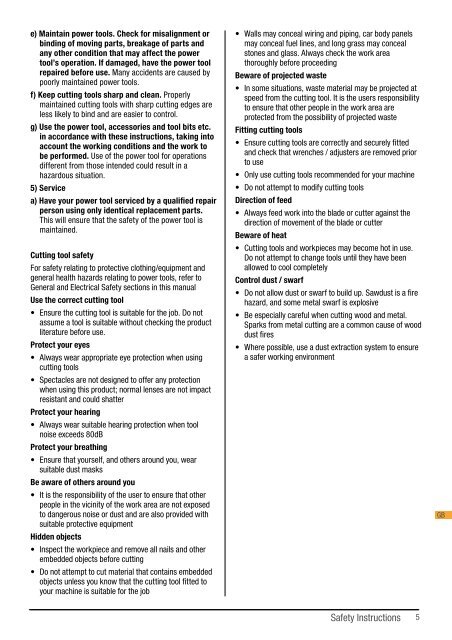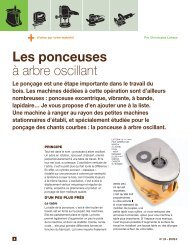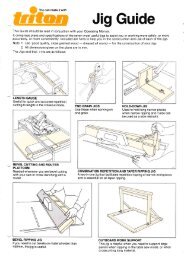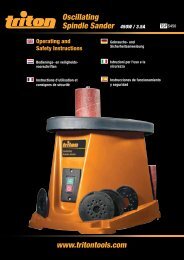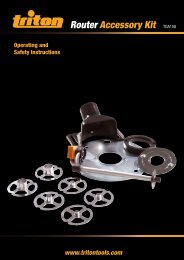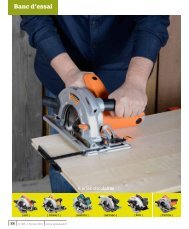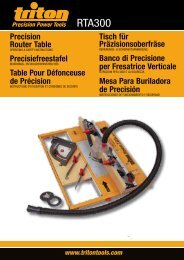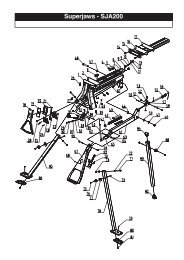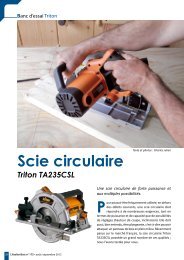Manual de instrucciones - Triton Tools
Manual de instrucciones - Triton Tools
Manual de instrucciones - Triton Tools
Create successful ePaper yourself
Turn your PDF publications into a flip-book with our unique Google optimized e-Paper software.
e) Maintain power tools. Check for misalignment or<br />
binding of moving parts, breakage of parts and<br />
any other condition that may affect the power<br />
tool’s operation. If damaged, have the power tool<br />
repaired before use. Many acci<strong>de</strong>nts are caused by<br />
poorly maintained power tools.<br />
f) Keep cutting tools sharp and clean. Properly<br />
maintained cutting tools with sharp cutting edges are<br />
less likely to bind and are easier to control.<br />
g) Use the power tool, accessories and tool bits etc.<br />
in accordance with these instructions, taking into<br />
account the working conditions and the work to<br />
be performed. Use of the power tool for operations<br />
different from those inten<strong>de</strong>d could result in a<br />
hazardous situation.<br />
5) Service<br />
a) Have your power tool serviced by a qualified repair<br />
person using only i<strong>de</strong>ntical replacement parts.<br />
This will ensure that the safety of the power tool is<br />
maintained.<br />
Cutting tool safety<br />
For safety relating to protective clothing/equipment and<br />
general health hazards relating to power tools, refer to<br />
General and Electrical Safety sections in this manual<br />
Use the correct cutting tool<br />
• Ensure the cutting tool is suitable for the job. Do not<br />
assume a tool is suitable without checking the product<br />
literature before use.<br />
Protect your eyes<br />
• Always wear appropriate eye protection when using<br />
cutting tools<br />
• Spectacles are not <strong>de</strong>signed to offer any protection<br />
when using this product; normal lenses are not impact<br />
resistant and could shatter<br />
Protect your hearing<br />
• Always wear suitable hearing protection when tool<br />
noise exceeds 80dB<br />
Protect your breathing<br />
• Ensure that yourself, and others around you, wear<br />
suitable dust masks<br />
Be aware of others around you<br />
• It is the responsibility of the user to ensure that other<br />
people in the vicinity of the work area are not exposed<br />
to dangerous noise or dust and are also provi<strong>de</strong>d with<br />
suitable protective equipment<br />
Hid<strong>de</strong>n objects<br />
• Inspect the workpiece and remove all nails and other<br />
embed<strong>de</strong>d objects before cutting<br />
• Do not attempt to cut material that contains embed<strong>de</strong>d<br />
objects unless you know that the cutting tool fitted to<br />
your machine is suitable for the job<br />
• Walls may conceal wiring and piping, car body panels<br />
may conceal fuel lines, and long grass may conceal<br />
stones and glass. Always check the work area<br />
thoroughly before proceeding<br />
Beware of projected waste<br />
• In some situations, waste material may be projected at<br />
speed from the cutting tool. It is the users responsibility<br />
to ensure that other people in the work area are<br />
protected from the possibility of projected waste<br />
Fitting cutting tools<br />
• Ensure cutting tools are correctly and securely fitted<br />
and check that wrenches / adjusters are removed prior<br />
to use<br />
• Only use cutting tools recommen<strong>de</strong>d for your machine<br />
• Do not attempt to modify cutting tools<br />
Direction of feed<br />
• Always feed work into the bla<strong>de</strong> or cutter against the<br />
direction of movement of the bla<strong>de</strong> or cutter<br />
Beware of heat<br />
• Cutting tools and workpieces may become hot in use.<br />
Do not attempt to change tools until they have been<br />
allowed to cool completely<br />
Control dust / swarf<br />
• Do not allow dust or swarf to build up. Sawdust is a fire<br />
hazard, and some metal swarf is explosive<br />
• Be especially careful when cutting wood and metal.<br />
Sparks from metal cutting are a common cause of wood<br />
dust fires<br />
• Where possible, use a dust extraction system to ensure<br />
a safer working environment<br />
GB<br />
Safety Instructions<br />
5


